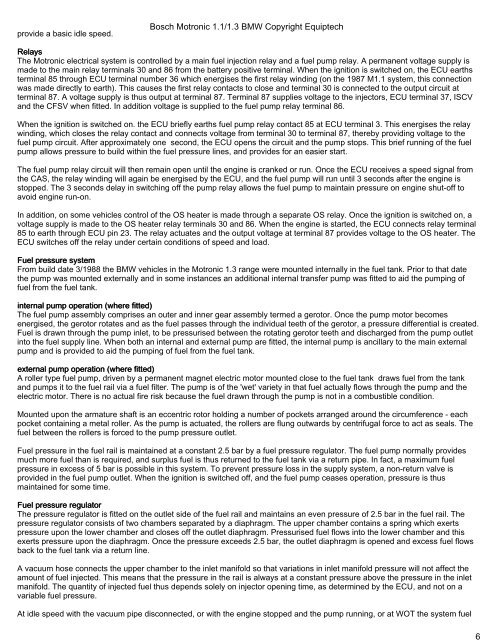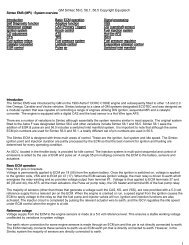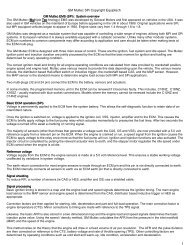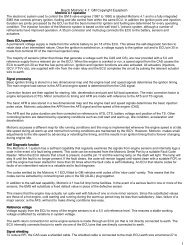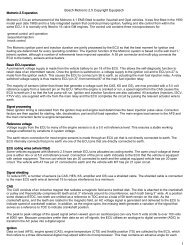Create successful ePaper yourself
Turn your PDF publications into a flip-book with our unique Google optimized e-Paper software.
6<br />
provide a basic idle speed.<br />
Bosch Motronic <strong>1.1</strong>/1.3 BMW Copyright Equiptech<br />
Relays<br />
The Motronic electrical system is controlled by a main fuel injection relay and a fuel pump relay. A permanent voltage supply is<br />
made to the main relay terminals 30 and 86 from the battery positive terminal. When the ignition is switched on, the ECU earths<br />
terminal 85 through ECU terminal number 36 which energises the first relay winding (on the 1987 M<strong>1.1</strong> system, this connection<br />
was made directly to earth). This causes the first relay contacts to close and terminal 30 is connected to the output circuit at<br />
terminal 87. A voltage supply is thus output at terminal 87. Terminal 87 supplies voltage to the injectors, ECU terminal 37, ISCV<br />
and the CFSV when fitted. In addition voltage is supplied to the fuel pump relay terminal 86.<br />
When the ignition is switched on. the ECU briefly earths fuel pump relay contact 85 at ECU terminal 3. This energises the relay<br />
winding, which closes the relay contact and connects voltage from terminal 30 to terminal 87, thereby providing voltage to the<br />
fuel pump circuit. After approximately one second, the ECU opens the circuit and the pump stops. This brief running of the fuel<br />
pump allows pressure to build within the fuel pressure lines, and provides for an easier start.<br />
The fuel pump relay circuit will then remain open until the engine is cranked or run. Once the ECU receives a speed signal from<br />
the CAS, the relay winding will again be energised by the ECU, and the fuel pump will run until 3 seconds after the engine is<br />
stopped. The 3 seconds delay in switching off the pump relay allows the fuel pump to maintain pressure on engine shut-off to<br />
avoid engine run-on.<br />
In addition, on some vehicles control of the OS heater is made through a separate OS relay. Once the ignition is switched on, a<br />
voltage supply is made to the OS heater relay terminals 30 and 86. When the engine is started, the ECU connects relay terminal<br />
85 to earth through ECU pin 23. The relay actuates and the output voltage at terminal 87 provides voltage to the OS heater. The<br />
ECU switches off the relay under certain conditions of speed and load.<br />
Fuel pressure system<br />
From build date 3/1988 the BMW vehicles in the Motronic 1.3 range were mounted internally in the fuel tank. Prior to that date<br />
the pump was mounted externally and in some instances an additional internal transfer pump was fitted to aid the pumping of<br />
fuel from the fuel tank.<br />
internal pump operation (where fitted)<br />
The fuel pump assembly comprises an outer and inner gear assembly termed a gerotor. Once the pump motor becomes<br />
energised, the gerotor rotates and as the fuel passes through the individual teeth of the gerotor, a pressure differential is created.<br />
Fuel is drawn through the pump inlet, to be pressurised between the rotating gerotor teeth and discharged from the pump outlet<br />
into the fuel supply line. When both an internal and external pump are fitted, the internal pump is ancillary to the main external<br />
pump and is provided to aid the pumping of fuel from the fuel tank.<br />
external pump operation (where fitted)<br />
A roller type fuel pump, driven by a permanent magnet electric motor mounted close to the fuel tank draws fuel from the tank<br />
and pumps it to the fuel rail via a fuel filter. The pump is of the 'wet' variety in that fuel actually flows through the pump and the<br />
electric motor. There is no actual fire risk because the fuel drawn through the pump is not in a combustible condition.<br />
Mounted upon the armature shaft is an eccentric rotor holding a number of pockets arranged around the circumference - each<br />
pocket containing a metal roller. As the pump is actuated, the rollers are flung outwards by centrifugal force to act as seals. The<br />
fuel between the rollers is forced to the pump pressure outlet.<br />
Fuel pressure in the fuel rail is maintained at a constant 2.5 bar by a fuel pressure regulator. The fuel pump normally provides<br />
much more fuel than is required, and surplus fuel is thus returned to the fuel tank via a return pipe. In fact, a maximum fuel<br />
pressure in excess of 5 bar is possible in this system. To prevent pressure loss in the supply system, a non-return valve is<br />
provided in the fuel pump outlet. When the ignition is switched off, and the fuel pump ceases operation, pressure is thus<br />
maintained for some time.<br />
Fuel pressure regulator<br />
The pressure regulator is fitted on the outlet side of the fuel rail and maintains an even pressure of 2.5 bar in the fuel rail. The<br />
pressure regulator consists of two chambers separated by a diaphragm. The upper chamber contains a spring which exerts<br />
pressure upon the lower chamber and closes off the outlet diaphragm. Pressurised fuel flows into the lower chamber and this<br />
exerts pressure upon the diaphragm. Once the pressure exceeds 2.5 bar, the outlet diaphragm is opened and excess fuel flows<br />
back to the fuel tank via a return line.<br />
A vacuum hose connects the upper chamber to the inlet manifold so that variations in inlet manifold pressure will not affect the<br />
amount of fuel injected. This means that the pressure in the rail is always at a constant pressure above the pressure in the inlet<br />
manifold. The quantity of injected fuel thus depends solely on injector opening time, as determined by the ECU, and not on a<br />
variable fuel pressure.<br />
At idle speed with the vacuum pipe disconnected, or with the engine stopped and the pump running, or at WOT the system fuel


